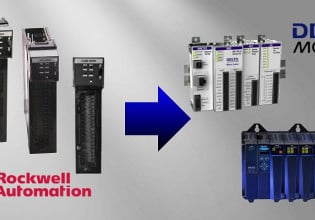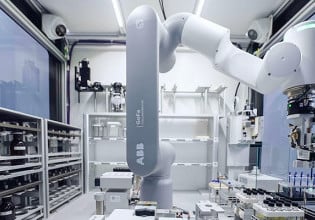Toposens’ Industrial-grade 3D Ultrasonic Sensors for Collision Avoidance
Toposens announces the world’s first 3D ultrasonic collision avoidance sensor for use in industrial environments to increase efficiency and safety with use of automated equipment.
Seven years of research and development at Toposens has produced the world’s first 3D, ultrasonic collision avoidance sensor for use in mobile robots. This ultrasonic sensor will likely see use in Autonomous Mobile Robots (AMRs), Automated Guided Vehicles (AGVs), automated forklifts, and other automated equipment that is used in picking, moving raw materials to feed locations, and moving finished products to shipping locations.

Toposens 3D ultrasonic sensor. Image used courtesy of Toposens
Toposens' Ultrasonic Sensor
Toposens' new sensor uses the reflections of ultrasonic pulses to determine where objects are located. The pulse travels from the sensor, bounces off an object, and returns to the detector. Because the difference in time between when the pulse was sent and when the reflection was received is known, the distance can be calculated. This is the “time-of-flight principle.”
However, simply recording one data point of the distance at one place is not enough to safely navigate a robot around objects and people. For this reason, the Toposens sensor uses a triangulation routine, meaning the reflection can be recorded from several locations. This improves the accuracy of the location of the object, plus, with enough of these signals, identifies the shape of the object in three dimensions. This helps identify smaller objects, such as shoes, forklift forks, and accidentally discarded or dropped objects that may be on the shop floor.
Once the location of objects has been established, Toposens’ proprietary algorithm determines the route that the robot must travel to avoid these objects. The complexity is in the software routines that process all of this incoming data at the high scan rates required to accurately model the shop floor. The faster the scan rates, the faster AMRs and AGVs can safely navigate the room.
Why use ultrasonic waves? Certain materials that are transparent to visible light, such as glass, and plastic, are hard to detect. They will reflect ultrasonic signals, meaning a robot can navigate around people carrying panes of glass or shipping departments where pallets are being wrapped in plastic cling, without incident. The ultrasonic signals also do not depend on the ambient lighting conditions of the room, meaning low-light environments can be navigated safely. This is a particular challenge for machine vision algorithms.

Even though automated forklifts have helped reduce worker injuries, collision avoidance sensors continue to be a weak point. Image used courtesy of Canva
Collision Avoidance
Forklift accidents are still a major source of injuries in the manufacturing and shipping spaces, and while automated forklifts have helped reduce these injuries, sometimes the collision avoidance sensors are the weak point. Many are simply not suitable for the harsh industrial environment.
Determining an appropriate path is particularly important for robots that will need to move around human workers. Humans are notoriously unpredictable in their motions, and a rapid scanning rate is essential for updating the robot on a path.

An AMR navigates around forklift forks, where the red zone is an automatic stop, the yellow zone is a warning (slow down) and green means the robot is safe to proceed. Image used courtesy of Toposens
For example, consider a human worker who leaves an area of a manufacturing line. As they leave, they remember that they need to bring their ID lanyard. They quickly double backwards, midstep, to retrieve their lanyard. An automated forklift, with a several ton load, needs every fraction of a second to apply brakes and slow down to avoid the unpredictable human. If the scan rate is too slow, the forklift will think the human has continued forward and could collide with them.
Toposens' Automation Solutions
Toposens hopes that their 3D ultrasonic collision avoidance sensor increases automation efficiency and safety. Toposens has been developing automation solutions for robots in the industrial setting since 2015, with a focus on algorithms and sensors required for collision avoidance. Their first inroads into this market was developing a toy fish that would navigate around real, living fish. Finding sensors and code suitable for this application was difficult, so they developed their own in-house.






